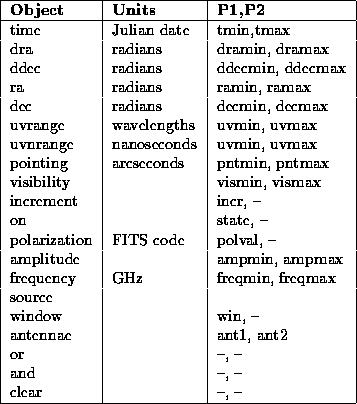
Table 2.4: Arguments to UVSELECT

Table 2.4: Arguments to UVSELECT
Another function performed by uvread is skip or flag data that is not required. The routine uvselect is used to instruct uvread on which data are to be selected and rejected. Normally the programmer will not call uvselect directly, but will use the SelInput and SelApply routines (see Section 2.6). The Users Manual gives a description about the way the user normally interacts with these routines.
Generally uvselect will be called many times, each call giving a different selection or discard criteria. The routines SelInput and SelApply merely sequentially parse and pass the user-given criteria to uvselect. Hence the `grammar' of the sequence of calls to uvselect (i.e. use of ``or'', or multiple occurrences of criteria based on the same parameter) is the same as the `grammar' of the user-specified task parameter. The `grammar' will not be repeated here.
The argument object is a string giving the parameter on which a select/discard criteria is based. The arguments p1 and p2 (both double precision) give added numerical parameters. Generally p1,p2 give a range of parameter values to select or discard. Note that the units of the values are consistent with the units of the underlying uv variables. These are not necessarily the most convenient units for the user, and so the user interface (given by SelInput and SelApply) performs some conversion between user-units and program-units.
There are a few additions objects, when compared with the SelInput and SelApply routines. These include the ra and dec objects, which give the pointing centre RA and DEC (after dra and ddec have been taken into account). Another is the and operator. Uvselect treates and and or as having identical precedence, and handles these operators in the order in which they are given. Beware of this lack of precedence.
The clear object causes the selection criteria to be reset to its default of selected everything.
The argument flag determines whether data which matches the associated criteria is to be selected ( flag=.true.) or discarded ( flag=.false.).
For example, to select data with Julian days 2444239.5 to 2444240.5 (i.e. data for 1 January, 1980), use:
call uvselect(tno,'time',2444239.5d0,2444240.5d0,.true.)To select all data, except for 1 January, 1980, use:
call uvselect(tno,'time',2444239.5d0,2444240.5d0,.false.)Note: In the 'antennae' criteria, an antennae number of 0 is treated as a ``match-all'' number.